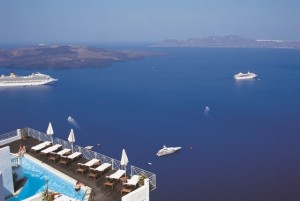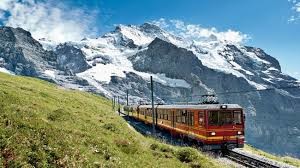
Santorini’s harbor is part of an ancient volcanic caldera that wiped out Minoan civilization. Photo from Visit Greece.
Here’s Part 2 of our two-part series on Ten Top European Natural Wonders, starring five more incredibly scenic spots on land, on water, and up in the sky:
The Greek Island of Santorini
If you bypass the often-crowded Aegean island of Santorini — also known as Thira or, in ancient times, Thera — due to its popularity as a sun-soaked tourist destination, you’ll also be missing one of the most memorable and expansive seascape panoramas in all of Europe.
Few views can compete with those from a terrace perched high atop the cliffs overlooking Santorini’s deep, seven-by- four-mile circle-shaped lagoon, formed from a mostly underwater caldera left by a titanic volcanic explosion some 36 centuries ago. One of the most powerful volcanic eruptions in history, it wiped out the island’s Minoan civilization and led to theories that ancient Thera was the site of Plato’s legendary Atlantis, which supposedly sank beneath the sea.
You can still trace the outline of the caldera in the circular shape formed by Santorini’s now-multiple islands, including the crab-shaped main island, which looks like it’s readying its claws to snap up the smaller island of Therasia across the lagoon. Four other uninhabited islands complete much of the rest of the circle, while two open portions lead out into the blue Aegean.
Sweden’s Northern Lights
While the Northern Lights – a kind of celestial light show composed of swirling greens, reds, and other hues that dance across the Arctic skies – can be seen from a number of northerly locales across the globe (including neighboring Scandinavian countries), they are at their most spectacular in far-northern Abisko, Sweden.
There, amid the mountainous, forested, snowy wilderness, you’ll find an average of more than 150 annual nights of these stunning light displays, set off by electrically charged particles darting through the atmosphere.
Peak seasons for the Northern Lights, also known as the aurora borealis, are October- November and February-March, but you might witness them any time from September into April in the low-light Abisko region. A chairlift climbs to the Aurora Sky Station, where a viewing platform sits at an elevation of nearly 3,000 feet. Dress warmly and prepare to be mesmerized.
The Alps of France, Switzerland, Italy, and Austria
The Alps are Europe’s iconic mountains, a 750-mile-long snow-capped range that extends from France through Switzerland, Austria, northern Italy and into parts of other countries as well.
Its best-known peaks – the pyramid-shaped Matterhorn, towering Mont Blanc, and the majestic Jungfrau — are among 82 summits reaching 13,000 feet or higher (Mt. Blanc is nearly 16,000 feet), many known for their ski resorts, challenging climbing routes, and stunning vistas.
Best viewing is from Chamonix in France (Mont Blanc), Zermatt in Switzerland (the Matterhorn), and the Interlaken region in Switzerland (the Jungfrau, Mönch and Eiger). You can ride cable cars up and down a number of peaks, or hop aboard the Jungfraujoch railway — a marvel of engineering dating from 1912 –to Europe’s highest train station at more than 11,000 feet.
Portugal’s Douro River Valley
Northern Portugal’s Douro River Valley, which has become a popular route for river cruising, is best known for its Port wine production, history, and remarkable scenery that changes with the seasons.
Running from the Spanish border west to the attractive Atlantic coastal city of Porto, the valley is lined by terraced vineyards, almond trees, and olive groves, cultivated on the hillsides for millennia. (Wine grapes have been grown here for 6,000 years).
Along with forested hills and riverside villages, the Douro and its tributaries are known for their biodiversity, harboring nature reserves that protect a number of endangered species, while archaeological parks display some of the world’s finest prehistoric rock art. For all its ancient roots, the Douro is just now being discovered as a tourist destination, so there’s no better time to go than now.
Denmark’s Faroe Islands
The remote Faroe Islands, an archipelago of 18 volcanic isles located in the North Atlantic between mainland Scandinavia and Iceland, offer some of the most dramatic seaside landscapes in Europe.
The islands’ 50,000 or so residents share the mountainous, rocky terrain with thousands of seabirds — puffins, guillemots, fulmars, cormorants, razorbills, gannets and the world’s largest colony of storm petrels — making this a prime spot for birdwatching.
Hiking here yields unforgettable views of steep coastal cliffs that plunge sharply to the ocean, while grassy heaths and deep blue lakes and fjords add swatches of texture and color.
Note: An earlier version of this piece appeared in StrideTravel.com, the website to consult when you’re looking for guided tours, unguided tours, and small-ship and river cruises worldwide.
















2 Responses to Top European Natural Wonders (Part 2)